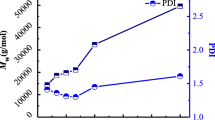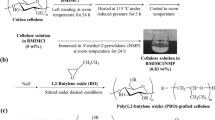Abstract
The internal plasticization of cellulose acetate (CA) was achieved by grafting with ε-caprolactone (CL) via reactive processing. The effect of varying concentrations of tin(II) bis(2-ethylhexanoate) [Sn(Oct)2] and iron(III) acetylacetonate [Fe(Acac)3] catalysts on the ring-opening polymerization (ROP) of CL were compared with each other. The analysis of processing parameters, weight loss measurements, FTIR, and 1H NMR spectrometry all showed improving grafting efficiency with increasing concentrations of both catalysts. Processing conditions also significantly affect the characteristics of the final product. The resulting structure, i.e., relatively long (2200 g/mol) PCL chains grafted to a small number (1–3%) of CA hydroxyls, promotes thermoplasticity, thus enabling processing in the melt state, while also preserving the biodegradable character of cellulose acetate. The performances of the two catalysts were found to be very similar, which suggests that conventional Sn(Oct)2 could be substituted with the less toxic Fe(Acac)3 for the graft ROP of caprolactone.
Graphic abstract










Similar content being viewed by others
Availability of data and material
The raw and processed data required to reproduce these findings cannot be shared at this time due to technical or time limitations.
References
Albertsson A-C, Varma IK (2002) Aliphatic polyesters: synthesis, properties and applications. In: Albertsson A-C (ed) Degradable aliphatic polyesters, Advances in polymer science, vol 157. Springer, Berlin, pp 1–40
Ali SFA, Fadl EA, William LA (2020) Cellulose acetate, cellulose acetate propionate and cellulose acetate butyrate membranes for water desalination applications. Cellulose 27(9525):9543. https://doi.org/10.1007/s10570-020-03434-w
Benoy CJ, Hooper PA, Schneider R (1971) The toxicity of tin in canned fruit juices and solid foods. Food Cosmet Toxicol 9(645):656. https://doi.org/10.1016/0015-6264(71)90152-0
Boyland E, Roe FJC, Millican K (1965) Effects of oral administration of two tin compounds to rats over prolonged periods. Food Cosmet Toxicol 3(277):280. https://doi.org/10.1016/S0015-6264(65)80085-2
Brydson JA (1989) The historical development of plastics materials. In: Brydson JA (ed) Plastics materials, 5th edn. Elsevier, London, pp 1–18
Casas A, Ramos MJ, Rodríguez JF, Pérez Á (2013) Tin compounds as Lewis acid catalysts for esterification and transesterification of acid vegetable oils. Fuel Process Technol 106(321):325. https://doi.org/10.1016/j.fuproc.2012.08.015
Champouret Y, Hashmi OH, Visseaux M (2019) Discrete iron-based complexes: applications in homogeneous coordination-insertion polymerization catalysis. Coord Chem Rev 390:127–170. https://doi.org/10.1016/j.ccr.2019.03.015
Chen Y-J, Fang H-J, Hsu SCN et al (2013) Improving the ring-opening polymerization of caprolactone and L-lactide using stannous octanoate. Polym Bull 70(993):1001. https://doi.org/10.1007/s00289-012-0864-1
Chen M-Z, Sun H-M, Li W-F et al. (2006) Synthesis, structure of functionalized N-heterocyclic carbene complexes of Fe(II) and their catalytic activity for ring-opening polymerization of ε-caprolactone. J Organomet Chem. 691(2489):2494. https://doi.org/10.1016/j.jorganchem.2006.01.031
Christian P, Jones IA (2001) Polymerisation and stabilisation of polycaprolactone using a borontrifluoride–glycerol catalyst system. Polymer (guildf) 42(3989):3994. https://doi.org/10.1016/S0032-3861(00)00735-7
Clarinval AM, Halleux J (2005) Classification of biodegradable polymers. In: Smith R (ed) Biodegradable polymers for industrial applications. Woodhead Publishing, Cambridge, pp 3–31
Dobrzynski P, Kasperczy KJ, Janeczek H, Bero M (2002) Synthesis of biodegradable glycolide/L-lactide copolymers using iron compounds as initiators. Polymer (guildf) 43:2595–2601. https://doi.org/10.1016/S0032-3861(02)00079-4
Dubois P, Narayan R (2003) Biodegradable compositions by reactive processing of aliphatic polyester/polysaccharide blends. Macromol Sym. 198(233):244. https://doi.org/10.1002/masy.200350820
Dubois P, Krishnan M, Narayan R (1999) Aliphatic polyester-grafted starch-like polysaccharides by ring-opening polymerization. Polymer (guildf) 40(3091):3100. https://doi.org/10.1016/s0032-3861(98)00110-4
Duda A, Penczek S, Kowalski A, Libiszowski J (2000) Polymerizations of ɛ-caprolactone and L, L-dilactide initiated with stannous octoate and stannous butoxide - a comparison. Macromol Symp 153:41. https://doi.org/10.1002/1521-3900(200003)153:1<41::AID-MASY41>3.0.CO;2-I
Edgar KJ, Buchanan CM, Debenham JS et al. (2001) Advances in cellulose ester performance and application. Prog Polym Sci 26(1605):1688. https://doi.org/10.1016/S0079-6700(01)00027-2
Fei P, Liao L, Cheng B, Song J (2017) Quantitative analysis of cellulose acetate with a high degree of substitution by FTIR and its application. Anal Methods. 9(6194):6201. https://doi.org/10.1039/C7AY02165H
Flugge LA, Blank JT, Petillo PA (1999) Isolation, modification, and NMR assignments of a series of cellulose oligomers. J Am Chem Soc 121(7228):7238. https://doi.org/10.1021/ja990561u
Fritsch P, de Saint Blanquat G, Derache R (1977) Effect of various dietary components on absorption and tissue distribution of orally administered inorganic tin in rats. Food Cosmet Toxicol 15(147):149. https://doi.org/10.1016/S0015-6264(77)80322-2
Garlotta D (2001) A Literature Review of Poly(Lactic Acid). J Polym Environ 9(63):84. https://doi.org/10.1023/A:1020200822435
de Groot AP, Feron VJ, Til HP (1973) Short-term toxicity studies on some salts and oxides of tin in rats. Food Cosmet Toxicol 11(19):30–10. https://doi.org/10.1016/0015-6264(73)90058-8
Gumel AM, Annuar MSM, Chisti Y (2013) Recent advances in the production, recovery and applications of polyhydroxyalkanoates. J Polym Environ 21(580):605. https://doi.org/10.1007/s10924-012-0527-1
Hatakeyama H, Yoshida T, Hatakeyama T (2000) The effect of side chain association on thermal and viscoelastic properties: cellulose acetate based polycaprolactones. J Therm Anal Calorim 59(157):168. https://doi.org/10.1023/A:1010140129888
Hege CS, Schiller SM (2014) Non-toxic catalysts for ring-opening polymerizations of biodegradable polymers at room temperature for biohybrid materials. Green Chem 16(1410):1416. https://doi.org/10.1039/C3GC42044B
Hiles RA (1974) Absorption, distribution and excretion of inorganic tin in rats. Toxicol Appl Pharmacol 27(366):379. https://doi.org/10.1016/0041-008X(74)90208-7
Huang M-H, Li S, Coudane J, Vert M (2003) Synthesis and characterization of block copolymers of ε-caprolactone and DL-lactide initiated by ethylene glycol or poly(ethylene glycol). Macromol Chem Phys. 204:1994–2001. https://doi.org/10.1002/macp.200350054
Imre B, Pukánszky B (2013) Compatibilization in bio-based and biodegradable polymer blends. Eur Polym J 49(1215):1233. https://doi.org/10.1016/j.eurpolymj.2013.01.019
Isikgor FH, Becer CR (2015) Lignocellulosic biomass: a sustainable platform for the production of bio-based chemicals and polymers. Polym Chem 6(4497):4559. https://doi.org/10.1039/c5py00263j
Jacobs C, Dubois P, Jerome R, Teyssie P (1991) Macromolecular engineering of polylactones and polylactides. 5. Synthesis and characterization of diblock copolymers based on poly-iε-caprolactone and poly(L, L or D, L)lactide by aluminum alkoxides. Macromolecules 24: 3027–3034. https://doi.org/10.1021/ma00011a001
Kowalski A, Duda A, Penczek S (1998) Kinetics and mechanism of cyclic esters polymerization initiated with tin(II) octoate, 1 Polymerization of ε-Caprolactone. Macromol Rapid Commun 19:567–572. https://doi.org/10.1002/(SICI)1521-3927(19981101)19:11<567::AID-MARC567>3.0.CO;2-T
Kowalski A, Libiszowski J, Majerska K et al. (2007) Kinetics and mechanism of ɛ-caprolactone and L, L-lactide polymerization coinitiated with zinc octoate or aluminum acetylacetonate: the next proofs for the general alkoxide mechanism and synthetic applications. Polymer (guildf) 48(3952):3960. https://doi.org/10.1016/j.polymer.2007.05.007
Kricheldorf HR, Kreiser-Saunders I, Damrau D-O (2000) Resorbable initiators for polymerizations of lactones. Macromol Symp 159:247–258. https://doi.org/10.1002/1521-3900(200010)159:1<247::AID-MASY247>3.0.CO;2-O
Kundys A, Plichta A, Florjańczyk Z et al. (2015) Screening of metal catalysts influence on the synthesis, structure, properties, and biodegradation of PLA-PBA triblock copolymers obtained in melt. J Polym Sci Part A Polym Chem 53(1444):1456. https://doi.org/10.1002/pola.27576
Lecomte P, Jérôme C (2011) Recent developments in ring-opening polymerization of lactones. In: Rieger B, Künkel A, Coates G et al (eds) Synthetic biodegradable polymers. Advances in polymer science, vol 245. Springer, Berlin, Heidelberg, pp 173–217
Lee S-H, Shiraishi N (2001) Plasticization of cellulose diacetate by reaction with maleic anhydride, glycerol, and citrate esters during melt processing. J Appl Polym Sci 81(243):250. https://doi.org/10.1002/app.1435
Luan Y, Wu J, Zhan M et al. (2013) “One pot” homogeneous synthesis of thermoplastic cellulose acetate-graft-poly(l-lactide) copolymers from unmodified cellulose. Cellulose. 20(327):337. https://doi.org/10.1007/s10570-012-9818-x
Molton PM, Demmitt TF (1977) Reaction mechnism of cellulose pyrolysis: a literature review. Richland, WA, USA
Murphy D, de Pinho MN (1995) An ATR-FTIR study of water in cellulose acetate membranes prepared by phase inversion. J Memb Sci 106(245):257. https://doi.org/10.1016/0376-7388(95)00089-U
Orelma H, Hokkanen A, Leppänen I et al (2020) Optical cellulose fiber made from regenerated cellulose and cellulose acetate for water sensor applications. Cellulose 27(1543):1553. https://doi.org/10.1007/s10570-019-02882-3
O’Keefe BJ, Breyfogle LE, Hillmyer MA, Tolman WB (2002) Mechanistic comparison of cyclic ester polymerizations by novel iron(III)-alkoxide complexes: single vs multiple site catalysis. J Am Chem Soc 124(4384):4393
Price DM, Church SP (1997) FTIR evolved gas analysis of the decomposition products of cellulose diacetate. Thermochim Acta 294(107):112. https://doi.org/10.1016/S0040-6031(96)03150-4
Quintana R, Persenaire O, Bonnaud L, Dubois P (2012) Recent advances in (reactive) melt processing of cellulose acetate and related biodegradable bio-compositions. Polym Chem 3(591):595. https://doi.org/10.1039/C1PY00421B
Raquez J-M, Narayan R, Dubois P (2008) Recent advances in reactive extrusion processing of biodegradable polymer-based compositions. Macromol Mater Eng 293(447):470. https://doi.org/10.1002/mame.200700395
Ratnikov EN, Naimark NI, Kryazhev VN, Romodanovskaya GV (1985) Change in the physicochemical characteristics of cellulose acetates under the action of high temperature. Fibre Chem 16(434):435. https://doi.org/10.1007/BF00546267
Rittinghaus RD, Schäfer PM, Albrecht P et al. (2019) New kids in lactide polymerization: highly active and robust iron guanidine complexes as superior catalysts. Chemsuschem 12(2161):2165. https://doi.org/10.1002/cssc.201900481
Samios E, Dart RK, Dawkins JV (1997) Preparation, characterization and biodegradation studies on cellulose acetates with varying degrees of substitution. Polymer (guildf) 38(3045):3054. https://doi.org/10.1016/S0032-3861(96)00868-3
Scott G (2000) ‘Green’ polymers. Polym Degrad Stab 68(1):7. https://doi.org/10.1016/S0141-3910(99)00182-2
Seddiqi H, Oliaei E, Honarkar H et al (2021) Cellulose and its derivatives: towards biomedical applications. Cellulose. https://doi.org/10.1007/s10570-020-03674-w
Shen Z, Wang J, Lu D et al (2015) Synthesis and properties of flexible polyurethane using ferric catalyst for hypopharyngeal tissue engineering. Biomed Res Int 2015:1–11. https://doi.org/10.1155/2015/798721
Shi R, Burt HM (2003) Synthesis and characterization of amphiphilic hydroxypropylcellulose-graft-poly(ε-caprolactone). J Appl Polym Sci 89:718–727. https://doi.org/10.1002/app.12194
Simon J, Müller HP, Koch R, Müller V (1998) Thermoplastic and biodegradable polymers of cellulose. Polym Degrad Stab 59(107):115. https://doi.org/10.1016/S0141-3910(97)00151-1
Stolt M, Krasowska K, Rutkowska M et al. (2005) More on the poly(L-lactide) prepared using ferrous acetate as catalyst. Polym Int 54(362):368. https://doi.org/10.1002/pi.1691
Storey RF, Sherman JW (2002) Kinetics and mechanism of the stannous octoate-catalyzed bulk polymerization of ε-caprolactone. Macromolecules 35(1504):1512. https://doi.org/10.1021/ma010986c
Tanzi MC, Verderio P, Lampugnani MG et al. (1994) Cytotoxicity of some catalysts commonly used in the synthesis of copolymers for biomedical use. J Mater Sci Mater Med 5(393):396. https://doi.org/10.1007/BF00058971
Vidéki B, Klébert S, Pukánszky B (2005) Grafting of caprolacton to cellulose acetate by reactive processing. Eur Polym J 41(1699):1707. https://doi.org/10.1016/j.eurpolymj.2005.03.002
Vidéki B, Klébert S, Pukánszky B (2007) External and internal plasticization of cellulose acetate with caprolactone: Structure and properties. J Polym Sci Part B Polym Phys 45(873):883. https://doi.org/10.1002/polb.2112
Vázquez-Torres H, Cruz-Ramos CA (1994) Blends of cellulosic esters with poly(caprolactone): characterization by DSC, DMA, and WAXS. J Appl Polym Sci 54(1141):1159. https://doi.org/10.1002/app.1994.070540818
Walker LP, Wilson DB, Irvin DC et al. (1992) Fragmentation of cellulose by the major Thermomonospora fusca cellulases, Trichoderma reesei CBHI, and their mixtures. Biotechnol Bioeng 40:1019–1026. https://doi.org/10.1002/bit.260400905
Wang J-L, Wang L, Dong C-M (2005) Synthesis, crystallization, and morphology of star-shaped poly(ɛ-caprolactone). J Polym Sci Part A Polym Chem 43(5449):5457. https://doi.org/10.1002/pola.20954
Warth H, Mülhaupt R, Schätzle J (1997) Thermoplastic cellulose acetate and cellulose acetate compounds prepared by reactive processing. J Appl Polym Sci 64:231. https://doi.org/10.1002/(SICI)1097-4628(19970411)64:2<231::AID-APP4>3.0.CO;2-S
Yamada T, Jung D-Y, Sawada R, Tsuchiya T (2008) Intracerebral microinjection of stannous 2-ethylhexanoate affects dopamine turnover in cerebral cortex and locomotor activity in rats. J Biomed Mater Res Part B Appl Biomater 87B(381):386. https://doi.org/10.1002/jbm.b.31115
Yoshioka M, Hagiwara N, Shiraishi N (1999) Thermoplasticization of cellulose acetates by grafting of cyclic esters. Cellulose 6(193):212. https://doi.org/10.1023/A:1009221730934
Acknowledgments
Lu Cui thanks the Stipendium Hungaricum Scholarship Programme and the China Scholarship Council (CSC) for providing scholarship and aiding to do research at the Budapest University of Technology and Economics
Funding
The research leading to these results received funding from the National Scientific Research Fund of Hungary (OTKA Grant No. K 120039), the Stipendium Hungaricum Scholarship Programme, and the China Scholarship Council (CSC).
Author information
Authors and Affiliations
Corresponding author
Ethics declarations
Conflicts of interest
The authors have no relevant financial or non-financial interests to disclose.
Human and animal rights
This study involved no human participants or animals.
Additional information
Publisher's Note
Springer Nature remains neutral with regard to jurisdictional claims in published maps and institutional affiliations.
Rights and permissions
About this article
Cite this article
Imre, B., Kiss, E.Z., Domján, A. et al. Ring-opening polymerization of ε-caprolactone from cellulose acetate by reactive processing. Cellulose 28, 9103–9116 (2021). https://doi.org/10.1007/s10570-021-04038-8
Received:
Accepted:
Published:
Issue Date:
DOI: https://doi.org/10.1007/s10570-021-04038-8




